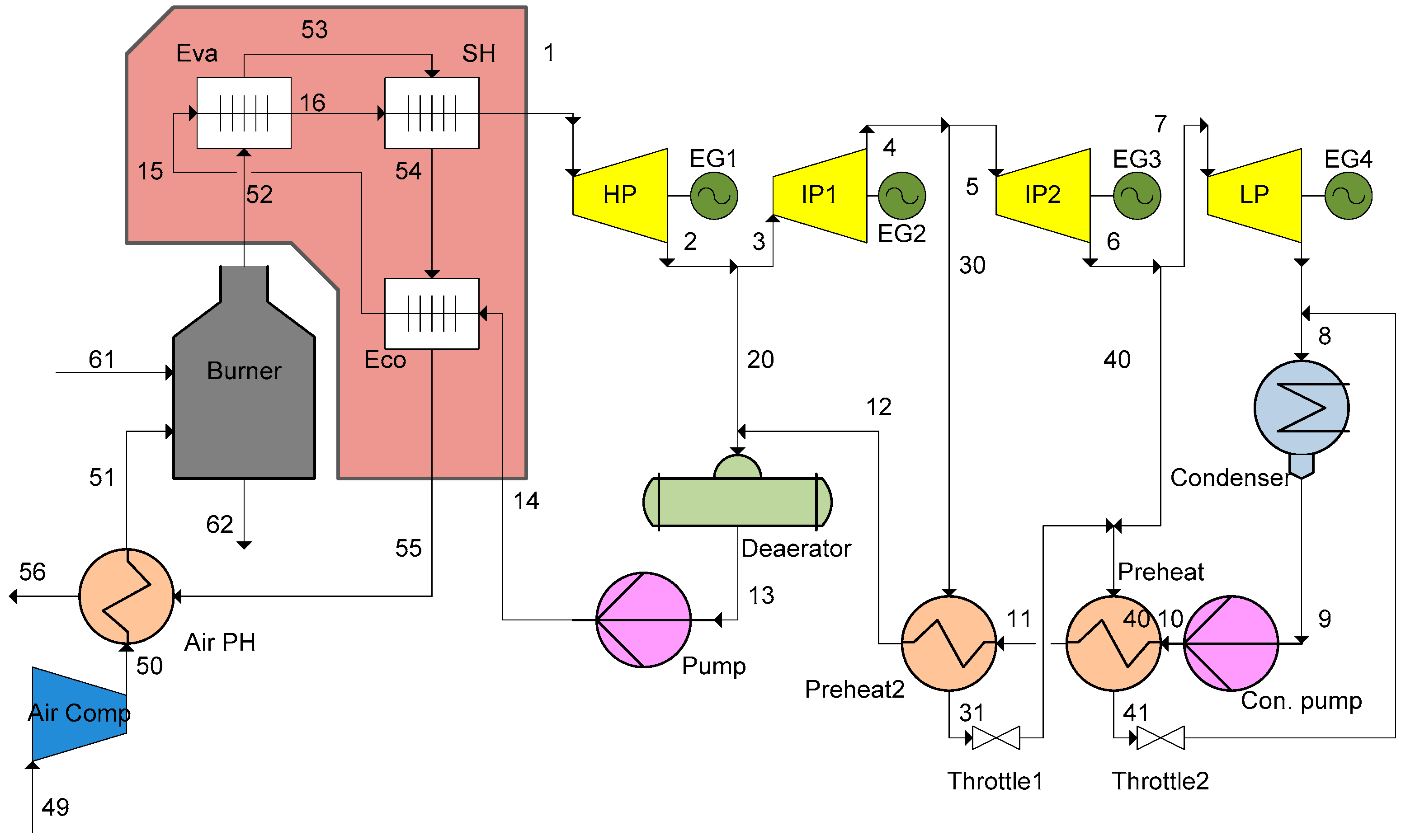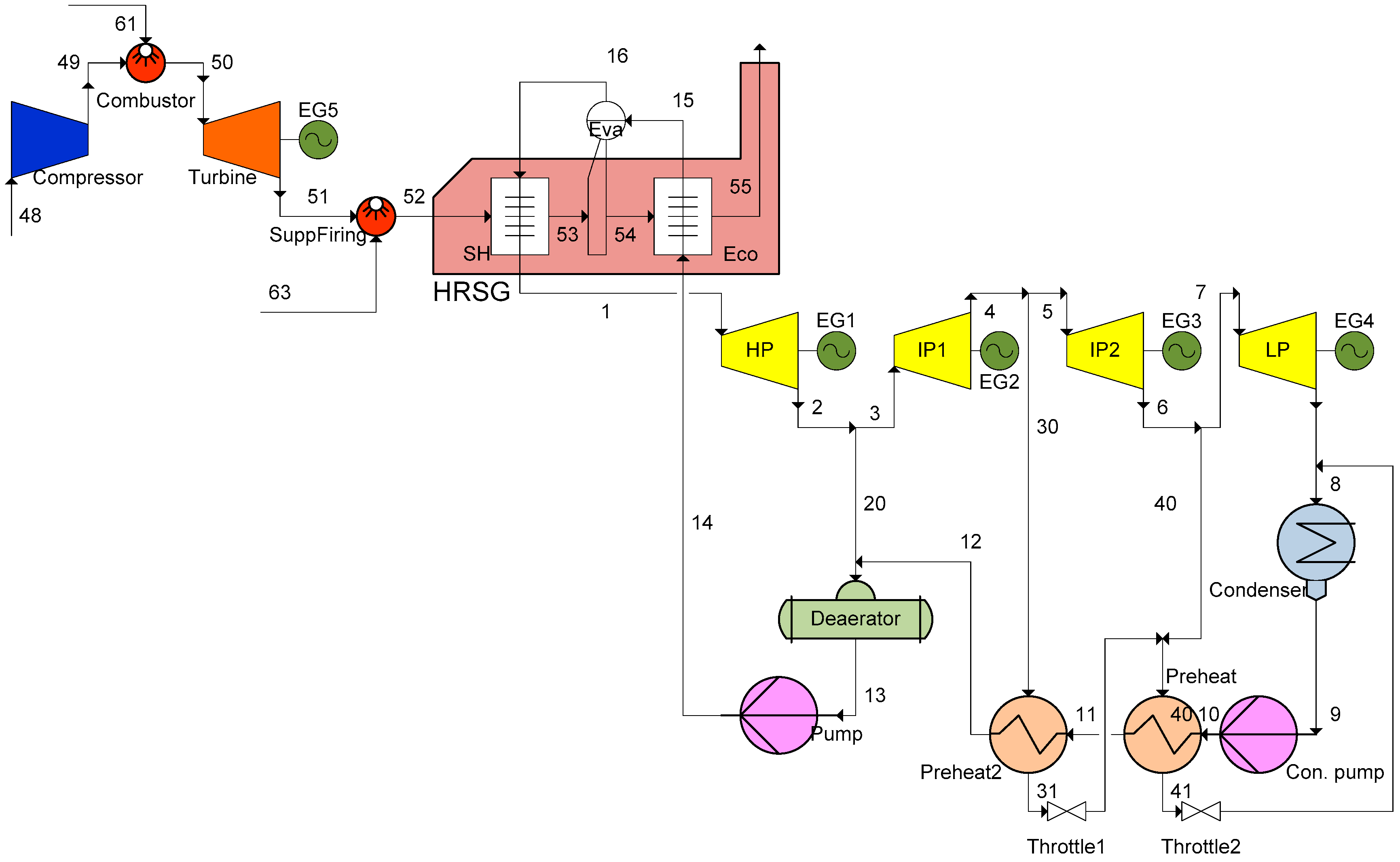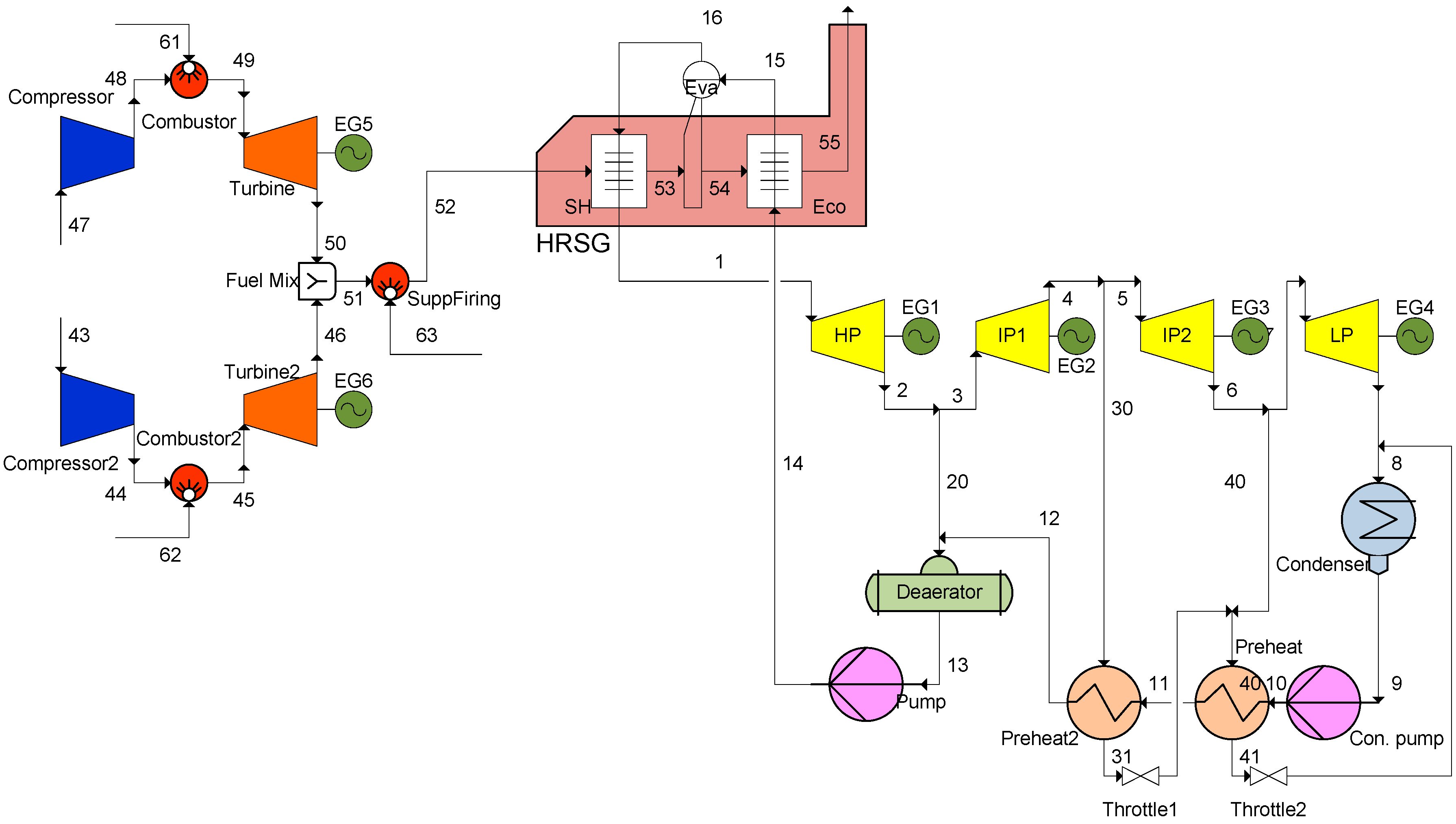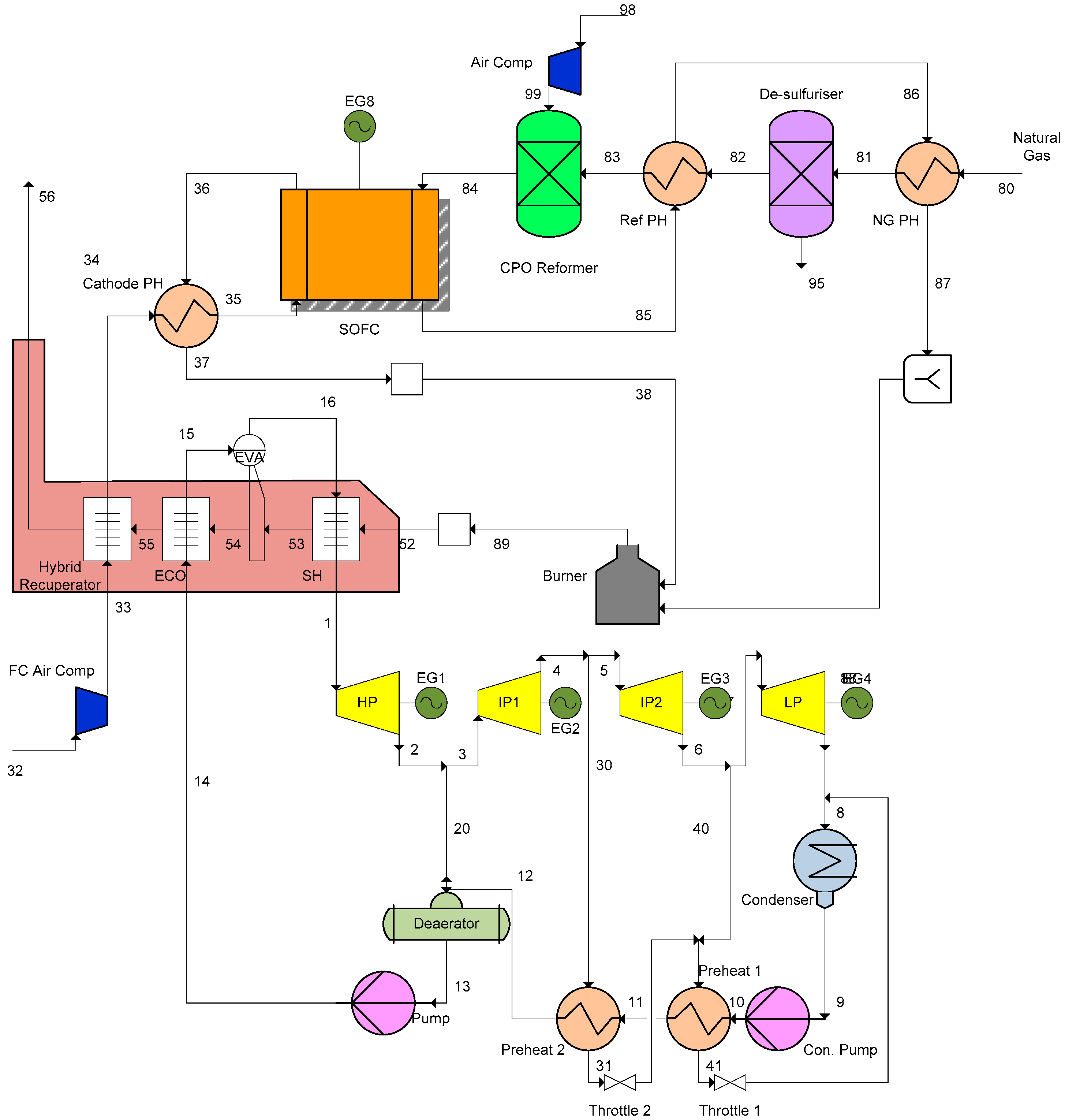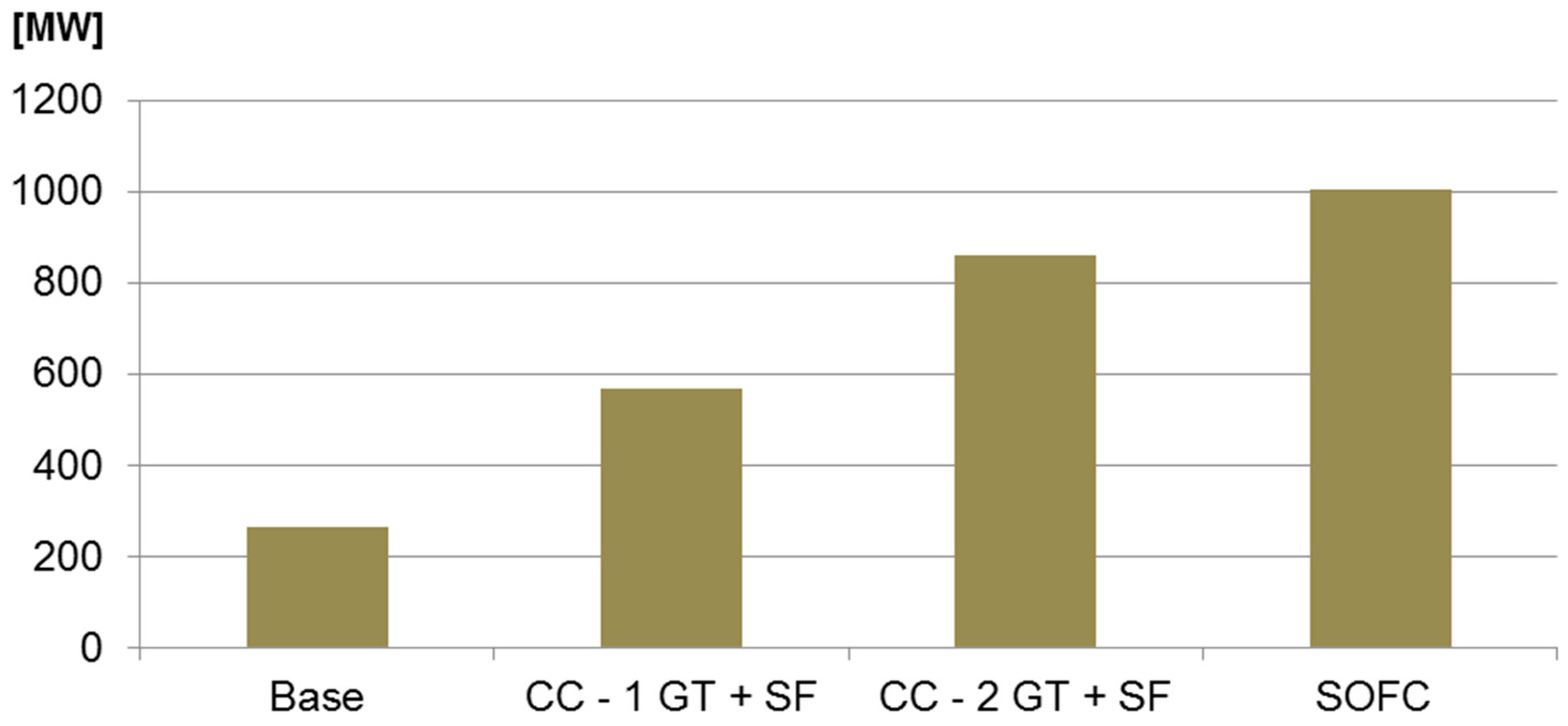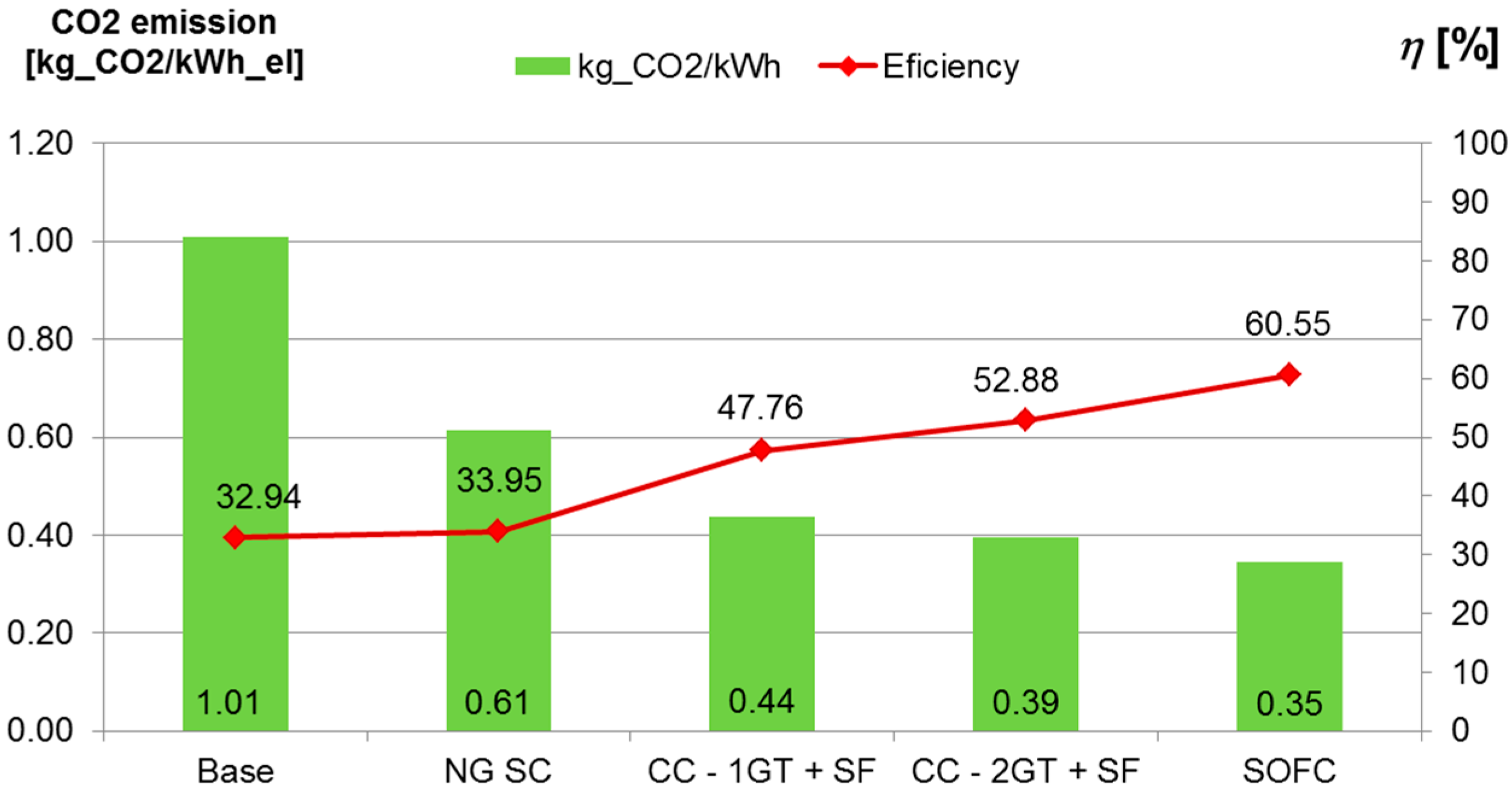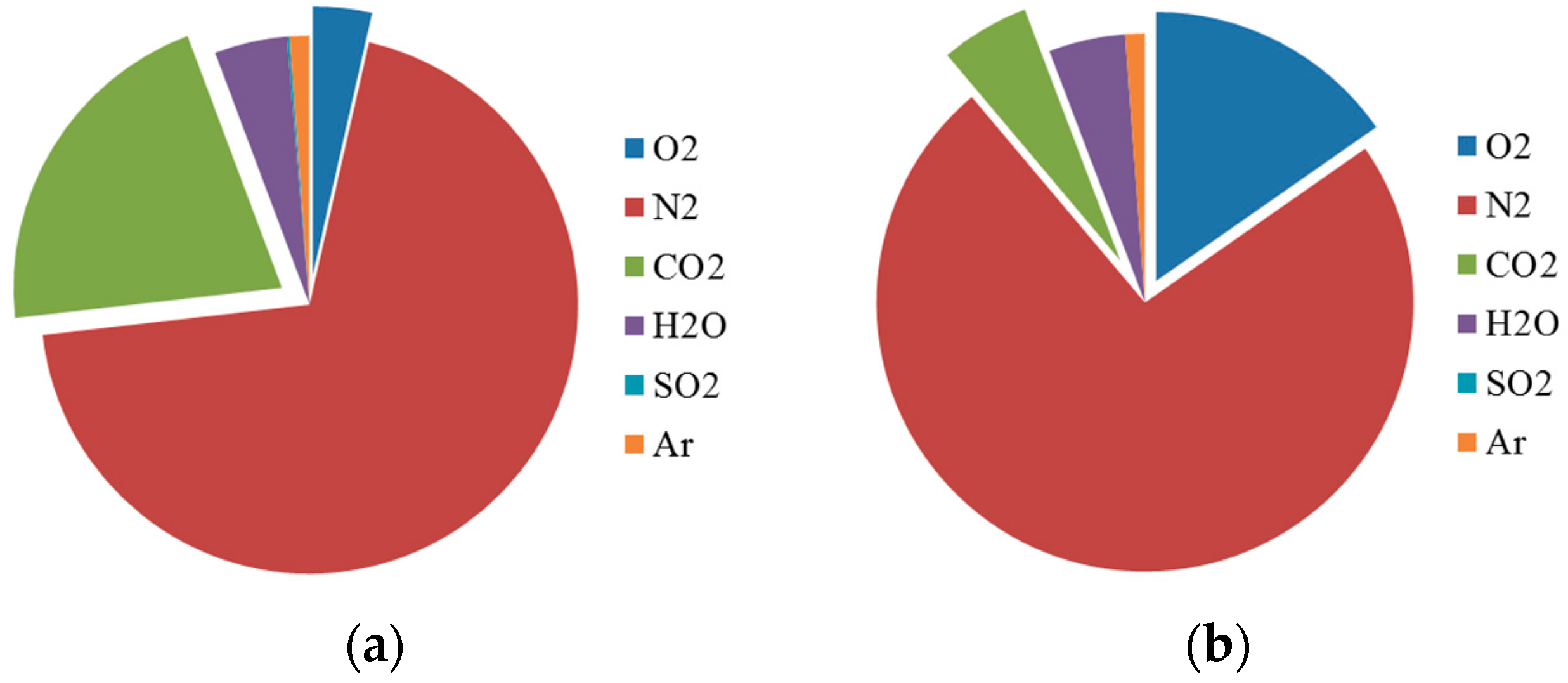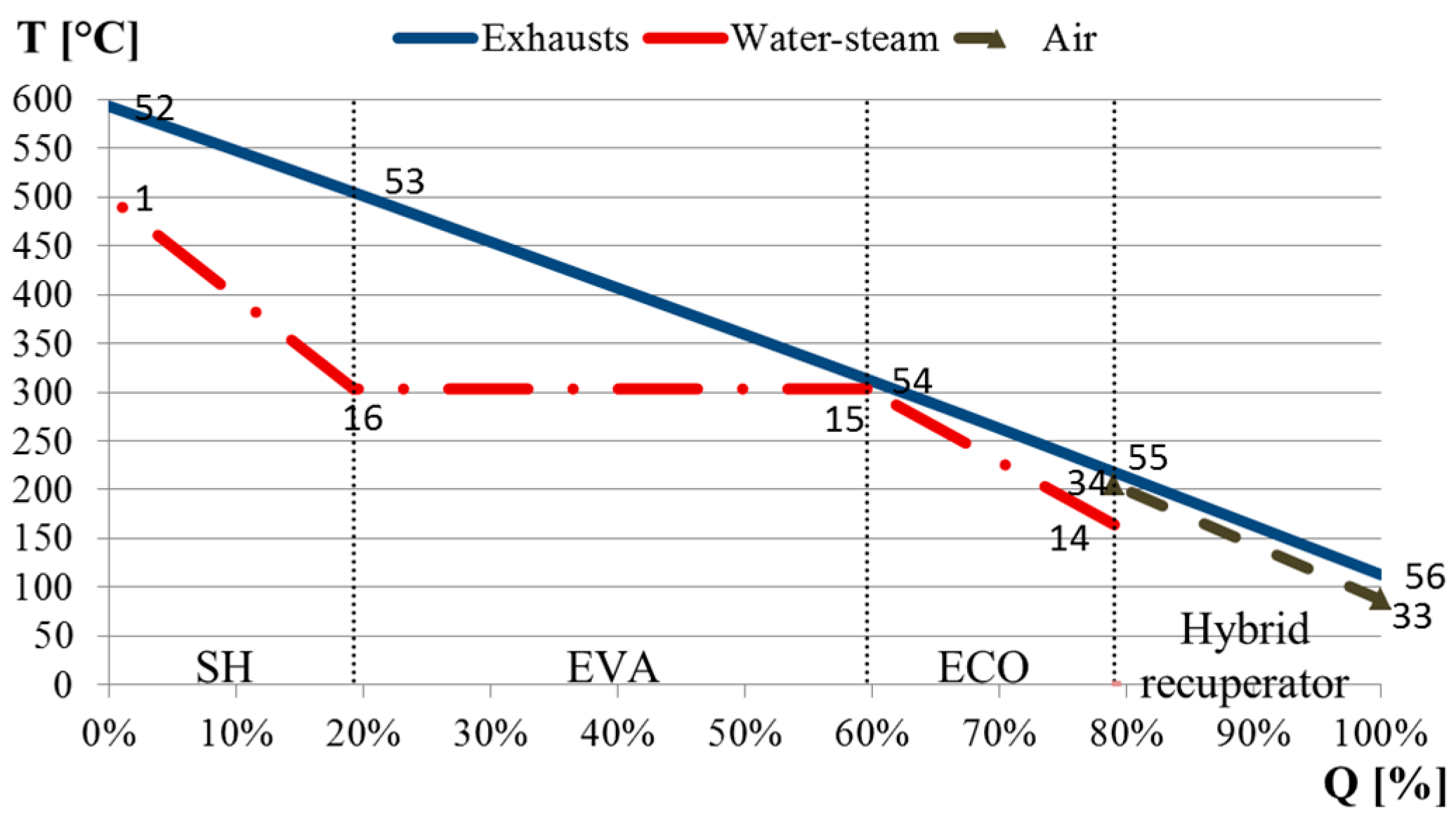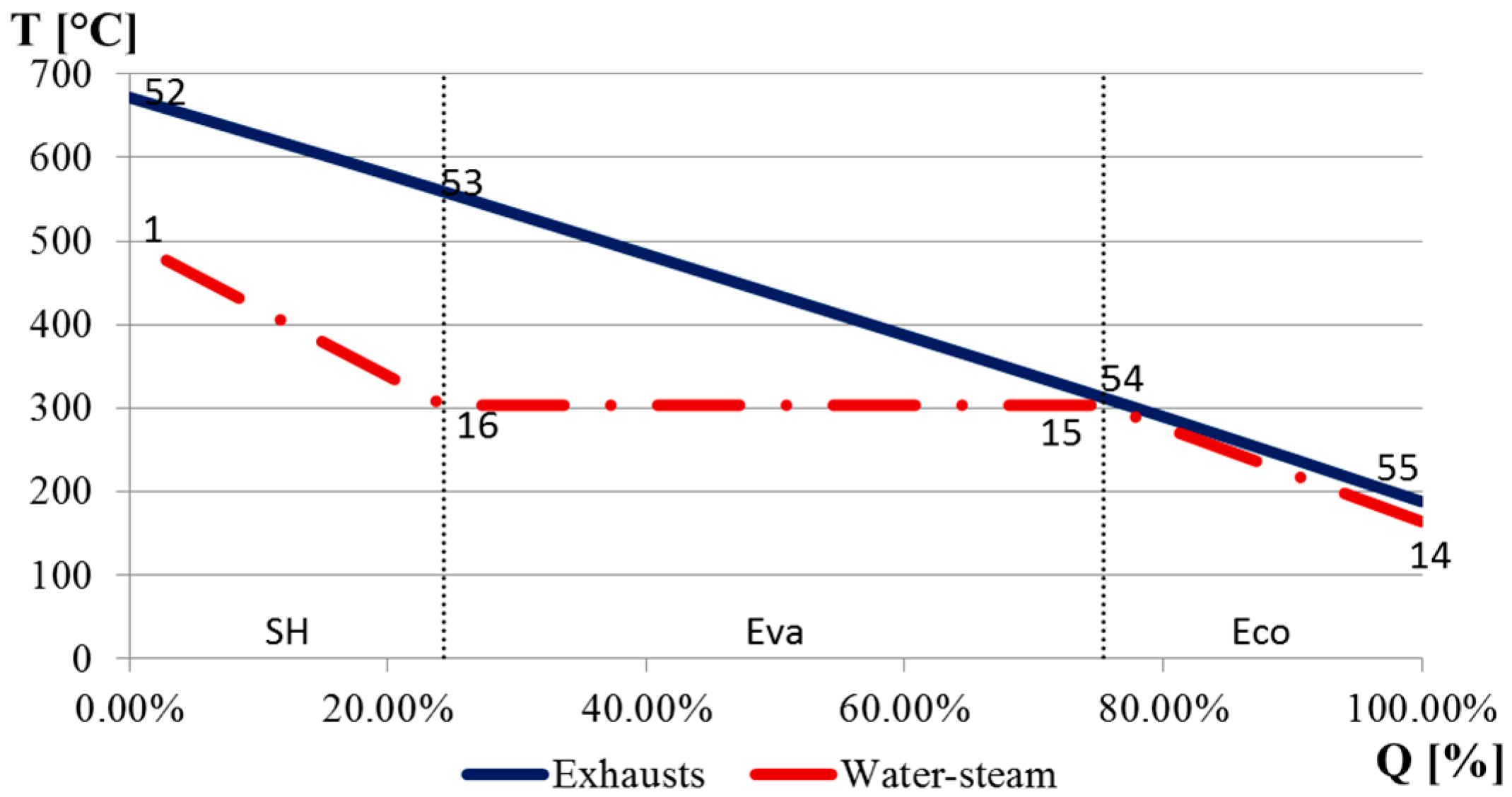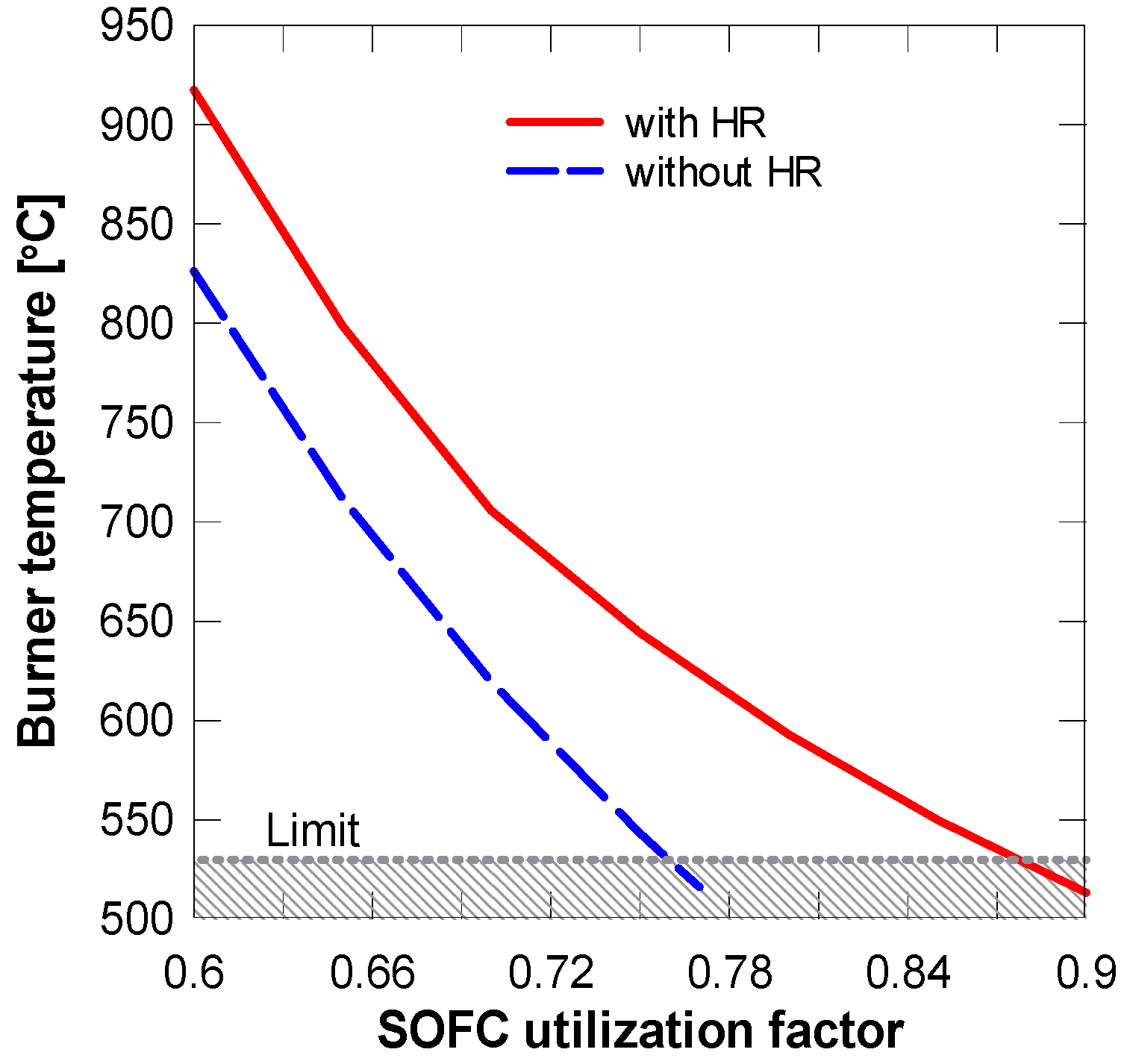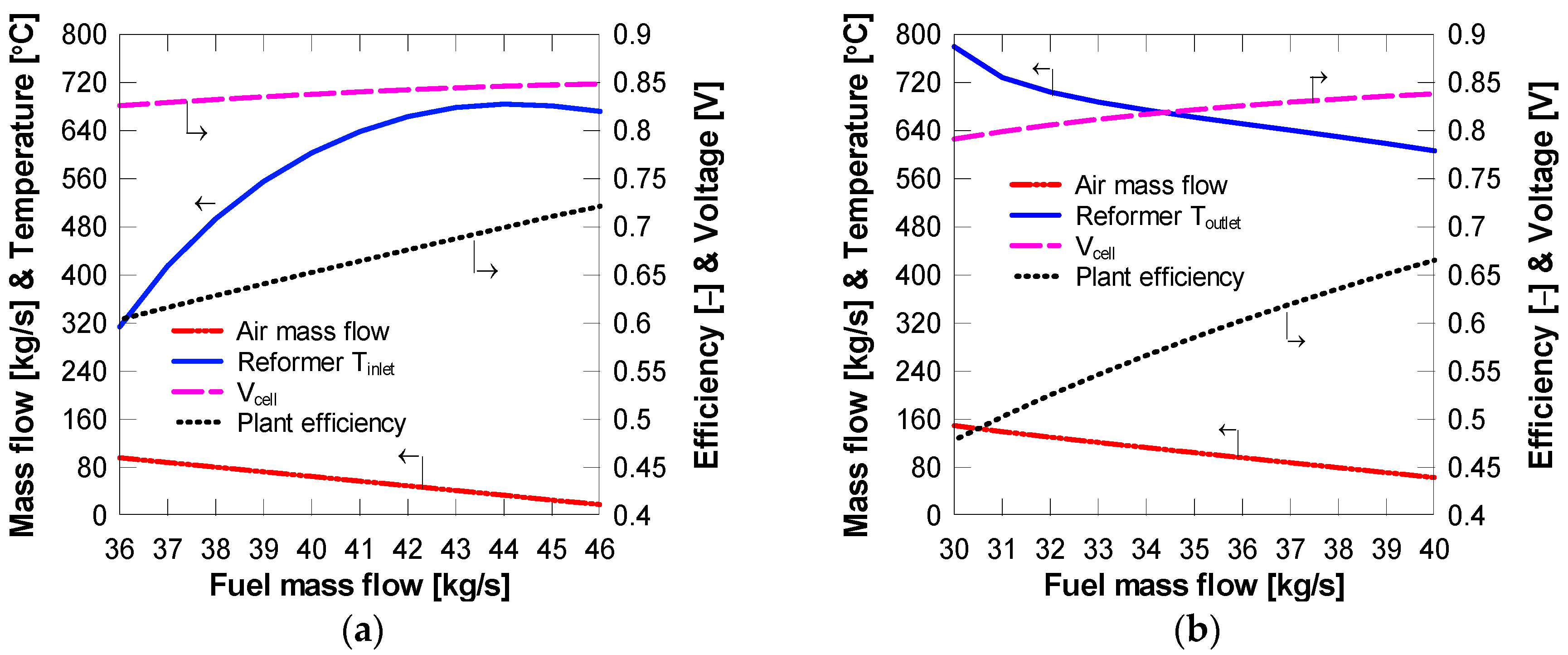The modeling for SOFC and gas turbine will be briefly explained below while modeling of other components will be referred to previous publications.
3.1. SOFC Modeling
The SOFC model developed in [
19] is used in this investigation, which is calibrated against experimental data for a planar SOFC type with a relative error of about ±3%. For the sake of clarity, it is briefly described here. In such modeling one must distinguish between electrochemical modeling, calculation of cell irreversibility (cell voltage efficiency) and the species compositions at outlet. For electrochemical modeling, the operational voltage (
Ecell) was found to be:
where
ENernst, Δ
Eact, Δ
Eohm and Δ
Econc are the Nernst ideal reversible voltage, activation polarization, ohmic polarization and concentration polarization, respectively. Assuming that only hydrogen is electrochemically converted, then the Nernst equation can be written as:
where Δ
gf0 is the Gibbs free energy (for H
2 reaction) at standard pressure. The water-gas shift reaction is very fast and therefore the assumption of hydrogen as only species to be electrochemically converted is justified, see [
20,
21]. In the above equations
pH2 and
pH2O are the partial pressures for H
2 and H
2O, respectively.
The activation polarization can be evaluated from the Butler-Volmer equation [
22,
23], which is isolated from other polarizations to determine the charge transfer coefficients and exchange current density from the experiment by the curve fitting technique. It follows that:
where
R,
T,
F and
i are the universal gas constant, operating temperature, Faraday constant and current density, respectively.
in is an internal current density added to the actual current density in order to account for the mixed potential caused by fuel crossover and electrons passing through the electrolyte. This value was adjusted when calibrating the electrochemical model against experimental data, found to be 2 mA/cm
2. The anodic [
24] and cathodic [
25] current densities are calculated from:
where
Eact,a =
Eact,c = 1.1 × 10
5 J/mol. The constants γ
a and γ
c are calibrated against experimental data and found to be 2.13 × 10
7 mA/cm
2 and 1.49 × 10
7 mA/cm
2, respectively [
19].
The ohmic polarization [
26] depends on the electrical conductivity of the electrodes as well as the ionic conductivity of the electrolyte. This was also calibrated against experimental data for a cell with anode thickness, electrolyte thickness, cathode thickness and interconnect thickness of 750, 40, 50 and 100 μm respectively and can be described as:
The constants σ
ohn,a, σ
ohn,c, σ
ohn,e and σ
ohn,i, are assumed to be 2.98 × 10
−6 kΩ·cm, 8.11 × 10
−6 kΩ·cm, 2.94 × 10
−6 kΩ·cm and 0.1256 × 10
−3 kΩ·cm respectively. The constants
Bohn,a,
bohn,c,
Bohn,e and
Bohn,i, are assumed to be −1392, 600, 10,350 and 4690 K, respectively [
19].
The concentration polarization is dominant at high current densities for anode-supported SOFCs, wherein insufficient amounts of reactants are transported to the electrodes and the voltage is then reduced significantly. Again the concentration polarization was calibrated against experimental data by introducing the anode limiting current, [
24], in which the anode porosity and tortuosity were also included among other parameters. Neglecting the cathode contribution (see e.g., [
27,
28]), it can be modeled as:
where
ne = 2,
pH2 and
pH2O are the partial pressures for H
2 and H
2O respectively. The anode limiting current
ias was assumed to be 1000 mA/cm
2 in the calibration.
It should be mentioned that the SOFC model developed here aims to represent the performance of the second generation SOFC stacks developed by from Topsoe Fuel Cell A/S (TOFC) and the Fuel Cells and Solid State Chemistry Division at Risø—DTU (Technical University of Denmark, Roskilde, Denmark). This SOFC type is anode supported and the anode consists of Ni/YSZ, the electrolyte of YSZ and the cathode of LSM/YSZ [
29]. As mentioned above, to fit the model with the desired stack performances, the electrochemical model is calibrated against experimental data, as shown in [
19].
The fuel composition at anode outlet was calculated using the Gibbs minimization method as described in [
30]. Equilibrium at the anode outlet temperature and pressure was assumed for the following species: H
2, CO, CO
2, H
2O, CH
4 and N
2. Thus the Gibbs minimization method calculates the compositions of these species at outlet by minimizing their Gibbs energy. The equilibrium assumption is fair because the methane content in this study is very low.
To calculate the voltage efficiency of the SOFC cells, the power production from the SOFC (
PSOFC) depends on the amount of chemical energy fed to the anode, the reversible efficiency (η
rev), the voltage efficiency (η
v) and the fuel utilization factor (
UF). It is defined in mathematical form as:
where
UF was a set value and η
v was defined as:
The reversible efficiency is the maximum possible efficiency defined as the relationship between the maximum electrical energy available (change in Gibbs free energy) and the fuels LHV (lower heating value) as follows, see e.g., [
31]:
The partial pressures were assumed to be the average between the inlet and outlet as:
Additionally, equations for conservation of mass (with molar flows), conservation of energy and conservation of momentum were also included into the model.
Table 3 displays the main parameters for the SOFC stacks used in this study.
3.3. Modeling of Selected Gas Turbine
In [
35] the specification of all gas turbines currently available in the market is specified. All gas turbines in the data sheet are screened and based on the required temperature as well as heat for the steam cycle, the gas turbine chosen here is the Siemens SGT5 4000F (Orlando, Florida, FL, USA). The specifications in [
35] are slightly different from the ones on the Siemens website [
36], which could depend on improvements. Therefore, an average data is chosen which is summarized in
Table 4. A gas turbine model based on these data is then developed here to capture all important specifications such as power output, efficiency,
etc.
As seen in the exhaust gas temperature if this gas turbine is well above live steam temperature of 500 °C, allowing for a large terminal temperature and consequently lower HRSG cost. In fact that the exhaust temperature of the gas turbine must be above 500 °C, eliminates the choice of many gas turbines listed in the screening process.
As mentioned above, the minimum power (heat) required for the steam plant is about 756 MW. From the gas turbine specifications one can calculate its exhaust power by:
which gives about 441 MW. This in turn means that one gas turbine alone will not be enough to generate the required steam and supplementary firing will be necessary. Another option would be using two gas turbines with or without supplementary firing.
In modeling ambient temperature and pressure are assumed to be 25 °C and 1.01 bar, respectively. Generator efficiency is assumed to be 97% which is a typical value. The calculated fuel mass flow and fuel consumption (based on LHV) are 16.08 kg/s respective 736.7 MW. The LHV of the fuel (natural gas) is assumed to be 45,810 kJ/kg.
The turbine inlet temperature set in the model does not correspond to the inlet temperature of the real gas turbine. In reality, during the expansion both gases and air cooling are mixed and results in a lower average temperature. However, in modeling cooling air is neglected and therefore the inlet temperature would be higher than the reality. Thermodynamically, the most important parameters would be gas turbine exhaust temperature, exhaust mass flow, fuel consumption, power production and efficiency which all are calculated correctly.
